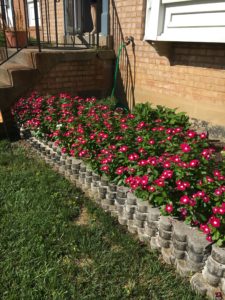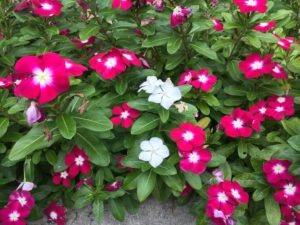In the Thousand Oaks community (where I live, and where the church is located), we have a modest population of wildlife—deer, rabbits, raccoons, some red foxes. They add character and beauty to the neighborhood, and I’m frankly happy to share the territory with them. Their eating habits present the only minor irritant. I have a couple of Azalea bushes in my front yard, along with a Hydrangea that I obtained from one of LRBC’s Easter displays a few years back. The deer have a particular fondness, it seems, for the fat blossoms that burst out on that Hydrangea in late Spring.
My next door neighbor, a senior adult named Gabby, overheard me expressing frustration one day as I surveyed my Hydrangea bush with bare stems poking out where flowers had once blossomed. “You should plant Periwinkle in front of your bushes,” she said, her German accent thick. “The deer hate it.” So early the next Spring, I heeded her suggestion and planted a bed of Vinca as a border around my Azalea and Hydrangea bushes. Her trick worked—deer didn’t seem to be interested in working around the new flower bed to get to my Hydrangea, and an added blessing was that I now had a very pleasant looking array of color in my front yard.
The only hassle with Periwinkle is that it is an annual flower, not a perennial. It dies at the end of the warm seasons. So every Spring I have to acquire a new tray of starter plants from our local nursery and replant them in my front yard. And, despite the extra time and effort, I do appreciate one of the benefits. I can plant a different color each Spring. This year, I decided to go with red.
It is now the end of August—the beginning of September is merely a couple of days away, with the first days of Autumn coming soon thereafter. My bed of Periwinkle is looking good.

I noticed something, though, when I returned home one day this past week early in the evening as the sun was setting. If you look closely at the picture above, you may be able to see it. That little splash of white . . .

Interesting. I didn’t plant any white Periwinkle this year. But . . . I do recall that last year’s color was white. Yes—one of last year’s plants evidently resurrected and wormed its way up through the new crop to display itself.
It’s the color scheme that causes me to interpret this as a Christian analogy, of course. White is so often used symbolically to represent Christ (think of the Advent wreath and the Christ candle). And to see this flower that was supposed to be dead miraculously emerging—white petals poking out of a sea of red—it is simply too perfect an illustration of Christ’s death and resurrection to ignore.
Jesus has overcome
And the grave is overwhelmed
The victory is won
He is risen from the dead
(from “I Will Rise” by Tomlin/Giglio/Maher)
It seems sort of strange to be celebrating a resurrection themed motif as we enter the season in which many things die. Case in point, in a mere short month or so that bed of Periwinkle will be a withering mass of brown leaves and twigs. But I can guarantee you one thing. This winter I will not be pulling the remnants of those plants out of the ground. I will trim the dead branches off, but the roots will be left alone. I now have faith in their potential for resurrection.
Hugs,
Mark
